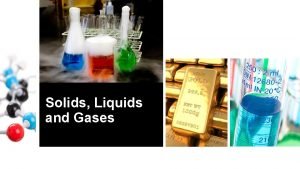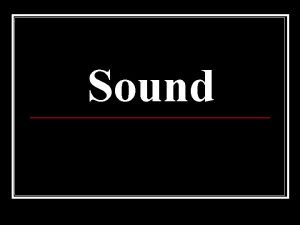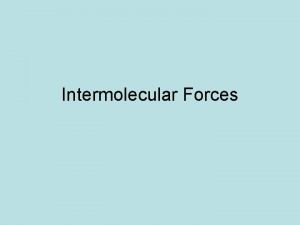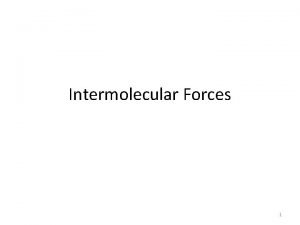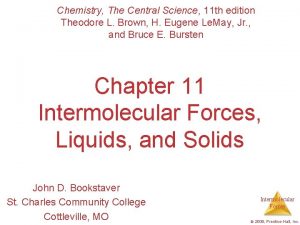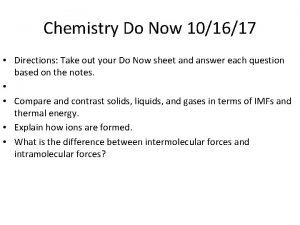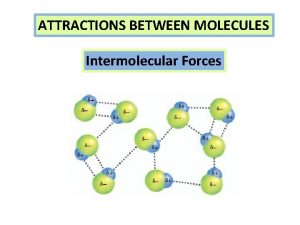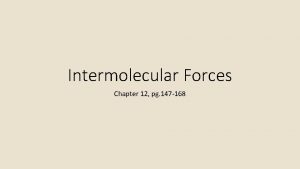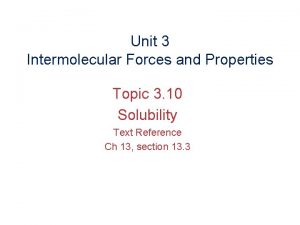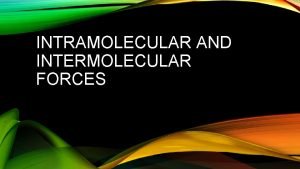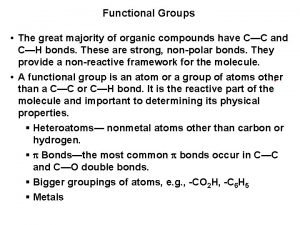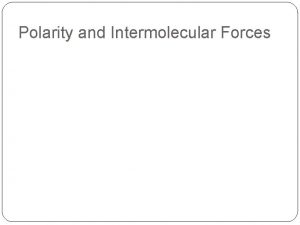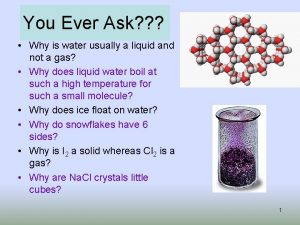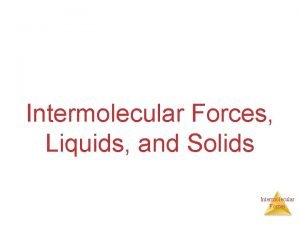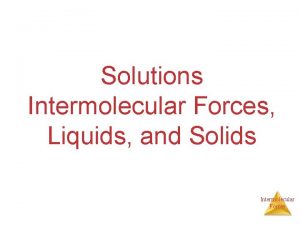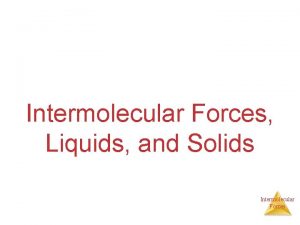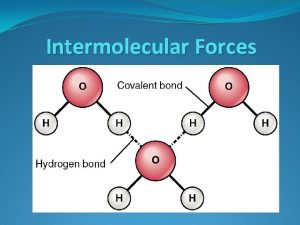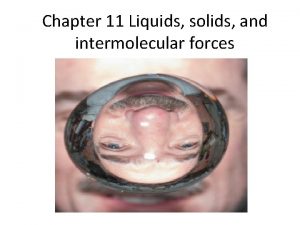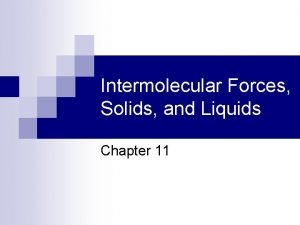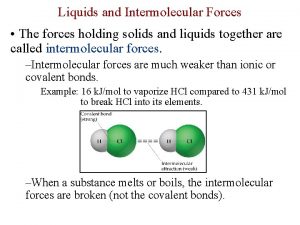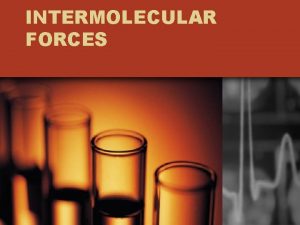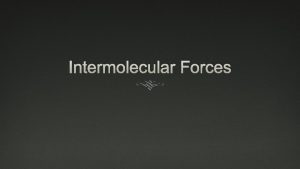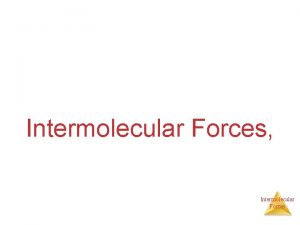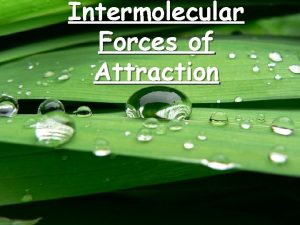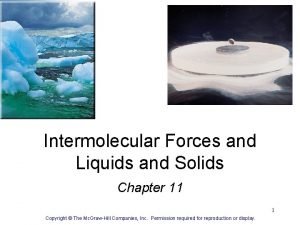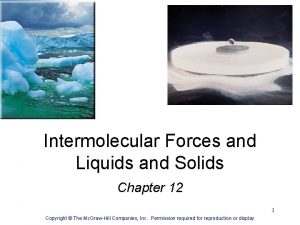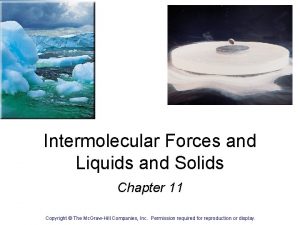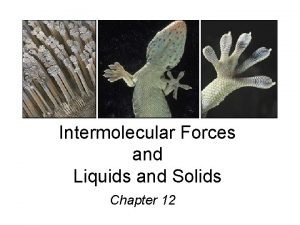INTERMOLECULAR FORCES Liquids and Solids Chapter 11 Liquids


































- Slides: 34

INTERMOLECULAR FORCES Liquids and Solids Chapter 11

Liquids vs. Solids �Physical properties are due to intermolecular forces �Understood in terms of kinetic-molecular theory �Gases are highly compressible and assume the shape and volume of their container �Liquids are almost incompressible, assume the shape but not the volume of the container �Solids are incompressible and have a definite shape and volume

Liquids vs. Solids �Solids and liquids are condensed phases �Converting a gas into a liquid or solid requires the molecules to get closer to each other �Forces holding solids and liquids together are called intermolecular forces

INTERMOLECULAR FORCES

Intermolecular Forces �Attraction between molecules �Weaker than ionic or covalent bonds (16 k. J/mol vs. 431 k. J/mol for HCl) �Melting or boiling breaks intermolecular forces �Condensing forms intermolecular forces �Melting points / Boiling points reflect strength of intermolecular forces �High melting/boiling points indicates strong attractive forces

Intermolecular Forces �Van der Waals forces exist between neutral molecules �Includes London-dispersion forces, dipole-dipole forces, and hydrogen-bonding forces �Ion-dipole interactions are important in solutions �ALL are WEAK electrostatic interactions �(~15% as strong as a covalent or ionic bond)

Van der Waals Forces �Ion-Dipole �Interaction between an ion and the partial charge on the end of a polar molecule (dipole) �Important in formation of solution between ionic substances in polar liquids (ex. Na. Cl in water) �Dipole-Dipole �Exist between neutral polar molecules �Polar molecules attract each other �Need to be close together to form strong attractions �Weaker than ion-dipole forces

Van der Waals Forces London Dispersion Forces �Weakest of all intermolecular forces �Possible for two adjacent neutral molecules to affect each other �Nucleus of one molecule (atom) attracts the electrons in an adjacent molecule (atom) �Electron “clouds” become distorted – temporary �Temporary distortion creates an instantaneous dipole �One instantaneous dipole can create an instantaneous dipole in a nearby molecule (atom) �Temporary dipoles attract each other

Van der Waals Forces London Dispersion Forces �Molecules must be very close together for these attractive forces to occur �Polarizability is the ease with which an electron cloud can be deformed �The larger the molecule- the more polarizable it is �Forces increase as molecular weight increases �Forces depend on the shape of the molecule

Van der Waals Forces Hydrogen Bonds �Boiling points of compounds with hydrogen bonded to an electronegative atom are abnormally high �Special case of dipole-dipole interactions �Requires: �H bonded to a small electronegative element �An unshared pair of electrons on a nearby small electronegative atom/ion �Hydrogen only has one electron, so in an electronegative bond it is “electron bare”

PROPERTIES IN LIQUIDS

Properties in Liquids � Viscosity is the resistance of a liquid to flow. � A liquid flows by sliding molecules over each other. � The stronger the intermolecular forces, the higher the viscosity. �Surface Tension � Bulk molecules (those in the liquid) are equally attracted to their neighbors. � Surface molecules are only attracted inwards towards the bulk molecules

Surface Tension

Surface Tension � Surface tension is the amount of energy required to increase the surface area of a liquid. � Cohesive forces bind molecules to each other. � Adhesive forces bind molecules to a surface � Meniscus is the shape of the liquid surface. � Adhesive > Cohesive : U-shaped meniscus (water) � Capillary Action: When a narrow glass tube is placed in water, the meniscus pulls the water up the tube

PHASE CHANGES

Phase Changes

Enthalpy of Phase Changes � Sublimation: Hsub > 0 (endothermic). � Vaporization: Hvap > 0 (endothermic). � Melting or Fusion: Hfus > 0 (endothermic). � Deposition: Hdep < 0 (exothermic). � Condensation: Hcon < 0 (exothermic). � Freezing: Hfre < 0 (exothermic).

Heating Curves � Plot of temperature change versus heat added is a heating curve. � During a phase change, adding heat causes no temperature change. � These points are used to calculate Hfus and Hvap. � Supercooling: When a liquid is cooled below its melting point and it still remains a liquid. � Achieved by keeping the temperature low and increasing kinetic energy to break intermolecular forces.


Critical Temperature and Pressure � Gases liquefied by increasing pressure at some temperature. � Critical temperature: the minimum temperature for liquefaction of a gas using pressure. � Critical pressure: pressure required for liquefaction.

Vapor Pressure on a Molecular Level

Vapor Pressure � Dynamic Equilibrium: the point when as many molecules escape the surface as strike the surface. � Vapor pressure is the pressure exerted when the liquid and vapor are in dynamic equilibrium. � Volatility, Vapor Pressure, and Temperature � If equilibrium is never established then the liquid evaporates. � Volatile substances evaporate rapidly. � The higher the temperature, the higher the average kinetic energy, the faster the liquid evaporates.

Vapor Pressure and Boiling Point � Liquids boil when the external pressure equals the vapor pressure. � Temperature of boiling point increases as pressure increases.

PHASE DIAGRAMS

Phase Diagrams

Phase Diagrams Water vs. Carbon Dioxide

SOLIDS

Unit Cells � Crystalline solid: well-ordered, definite arrangements of molecules, atoms or ions. � Crystals have an ordered, repeated structure. � The smallest repeating unit in a crystal is a unit cell. � Unit cell is the smallest unit with all the symmetry of the entire crystal. � Three-dimensional stacking of unit cells is the crystal lattice.

Unit Cell vs. Lattice

Three common types of unit cell. �Primitive cubic, atoms at the corners of a simple cube, � each atom shared by 8 unit cells; �Body-centered cubic (bcc), atoms at the corners of a cube plus one in the center of the body of the cube, � corner atoms shared by 8 unit cells, center atom completely enclosed in one unit cell; �Face-centered cubic (fcc), atoms at the corners of a cube plus one atom in the center of each face of the cube, � corner atoms shared by 8 unit cells, face atoms shared by 2 unit cells.

Unit Cells

Solids: Four Types � Molecular (formed from molecules) - usually soft with low melting points and poor conductivity. �Covalent network (formed from atoms) - very hard with very high melting points and poor conductivity. �Ions (formed from ions) - hard, brittle, high melting points and poor conductivity. �Metallic (formed from metal atoms) - soft or hard, high melting points, good conductivity, malleable and ductile.

Covalent Network Solid

Ionic Lattice � Cs. Cl Structure �Cs+ has a coordination number of 8. � Cation to anion ratio is 1: 1. � Zinc Blende Structure (Zn. S). � S 2 - ions adopt a fcc arrangement. � Zn 2+ ions have a coordination number of 4. � The S 2 - ions are placed in a tetrahedron around the Zn 2+ ions. � Fluorite Structure (Ca. F 2). � Ca 2+ ions in a fcc arrangement. � There are twice as many F- per Ca 2+ ions in each unit cell.
 Intermolecular and intramolecular forces
Intermolecular and intramolecular forces Intermolecular vs intramolecular
Intermolecular vs intramolecular Intermolecular force of attraction
Intermolecular force of attraction Chapter 14 solids liquids and gases worksheet answers
Chapter 14 solids liquids and gases worksheet answers Kinetic molecular theory of solids
Kinetic molecular theory of solids Chapter 11 - states of matter: liquids and solids
Chapter 11 - states of matter: liquids and solids Thermal expansion and contraction examples
Thermal expansion and contraction examples Buoyancyability
Buoyancyability Solid liquid gas examples
Solid liquid gas examples Conduction convection radiation venn diagram
Conduction convection radiation venn diagram Properties of solids liquids and gases with examples
Properties of solids liquids and gases with examples Combined gas law def
Combined gas law def Adhesive force
Adhesive force Liquids and solids menu
Liquids and solids menu Lesson outline lesson 1 solids liquids and gases answer key
Lesson outline lesson 1 solids liquids and gases answer key Liquids and solids
Liquids and solids Particle movement in solids liquids and gases
Particle movement in solids liquids and gases How does sound travel through solids liquids and gases
How does sound travel through solids liquids and gases Properties of solid liquid and gas
Properties of solid liquid and gas Motion of particles in solids, liquids and gases
Motion of particles in solids, liquids and gases Gas from becomes easier to compress
Gas from becomes easier to compress Specific cake resistance formula
Specific cake resistance formula Hydrogen bromide intermolecular forces
Hydrogen bromide intermolecular forces Van der waals gecko
Van der waals gecko Intermolecular forces
Intermolecular forces Viscosity and intermolecular forces
Viscosity and intermolecular forces Intermolecular forces capillary action
Intermolecular forces capillary action Strength of intermolecular forces
Strength of intermolecular forces Interatomic and intermolecular forces
Interatomic and intermolecular forces Unit 3 intermolecular forces and properties
Unit 3 intermolecular forces and properties Phase diagram of carbon dioxide
Phase diagram of carbon dioxide Electronegativity intermolecular forces
Electronegativity intermolecular forces Intermolecular forces of functional groups
Intermolecular forces of functional groups Intermolecular forces review
Intermolecular forces review Ch2cl intermolecular forces
Ch2cl intermolecular forces















